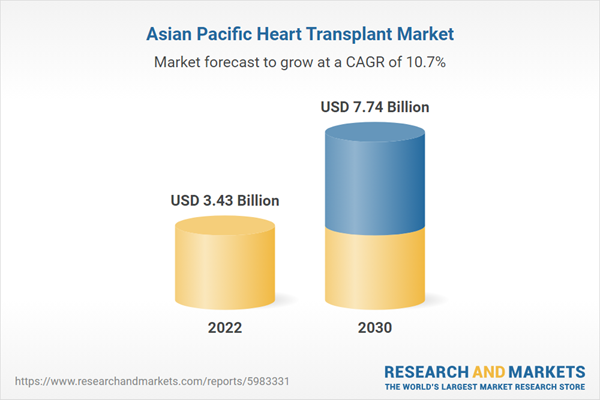Growing Geriatric Population Boosts Asia Pacific Heart Transplant Market
The geriatric population is prone to CVDs, orthopedic disorders, metabolic disorders, and neurological disorders, among others. According to the WHO, the aging population across the world is likely to rise from ~1 billion in 2019 to ~2.1 billion by 2050. With China and India accounting for more than one billion people each, Asia's population surpassed 4.5 billion as of 2020, making up more than half of the world's total population. Asians were predicted to number 414 million, which is around 20% more than the 331.4 million Americans who are 65 years of age or older. By 2050, it is expected that Asia will have over 923 million elderly population. Hence, the growing elderly population, along with the increasing prevalence of heart failure, fuels the heart transplant market growth.Asia Pacific Heart Transplant Market Overview
The Asia Pacific heart transplant market is segmented into China, India, Japan, South Korea, Australia, and the Rest of Asia Pacific. Asia Pacific is expected to register the fastest CAGR in the global market during the forecast period. The market growth in this region is ascribed to the rise in healthcare awareness of the importance of organ donation and a surge in social media marketing to encourage a positive attitude toward organ donation. Additionally, advancing healthcare infrastructure and increasing investments to boost manufacturing capacities are projected to drive the Asia Pacific heart transplant market during the forecast period. According to an article published in BioMed Central, more than 40% of the deaths in China are attributed to CVDs. In addition, in 2019, about 120.33 million people suffered from CVDs in China. Rapid socioeconomic progress is impacting the lifestyle of the population in China, which, in turn, increases the chances of contracting CVDs, conditions of heart or blood vessels that may result in heart failure. At present, heart transplantation is the only well-known effective treatment for advanced heart failure. However, owing to the limited number of heart donors, only ~300 heart transplants are performed in China annually. Therefore, people suffering from heart failure opt for artificial heart transplants due to the long waiting list for heart transplantation.Asia Pacific Heart Transplant Market Segmentation
The Asia Pacific heart transplant market is segmented into surgery type, type, end user, and country.Based on surgery type, the Asia Pacific heart transplant market is bifurcated into orthotopic heart transplantation and heterotopic heart transplantation. The orthotopic heart transplantation segment held a larger share of the Asia Pacific heart transplant market in 2022.
In terms of type, the Asia Pacific heart transplant market is bifurcated into donor live heart and artificial heart. The donor live heart segment held a larger share of the Asia Pacific heart transplant market in 2022. Further, artificial heart segment is categorized into ventricular assisted device and total artificial heart.
Based on end user, the Asia Pacific heart transplant market is segmented into hospitals, cardiac centres, and others. The hospitals segment held the largest share of the Asia Pacific heart transplant market in 2022.
Based on country, the Asia Pacific heart transplant market is segmented into China, India, South Korea, Japan, Australia, and the Rest of Asia Pacific. China dominated the Asia Pacific heart transplant market in 2022.
Terumo Corp, Abbott Laboratories, SynCardia Systems LLC, BiVACOR Inc, BioVentrix Inc, and LivaNova Plc are some of the leading companies operating in the Asia Pacific heart transplant market.
Table of Contents
Companies Mentioned
- Terumo Corp
- Abbott Laboratories
- SynCardia Systems LLC
- BiVACOR Inc
- BioVentrix Inc
- LivaNova Plc
Table Information
| Report Attribute | Details |
|---|---|
| No. of Pages | 70 |
| Published | May 2024 |
| Forecast Period | 2022 - 2030 |
| Estimated Market Value ( USD | $ 3.43 Billion |
| Forecasted Market Value ( USD | $ 7.74 Billion |
| Compound Annual Growth Rate | 10.7% |
| Regions Covered | Asia Pacific |
| No. of Companies Mentioned | 6 |









